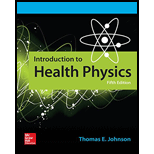
Concept explainers
The absorbed dose to the lung during 13-week period and during the 1-year period immediately following inhalation.
Answer to Problem 11.1P
In 13 weeks absorbed dose is
Explanation of Solution
Given:
Mean radioactivity concentration,
Formula used The effective half-life
The effective clearance rate constant for these particles is
The cumulated activity for all four compartments after
The dose from the activity in the lung is given
Calculation:
Since no particle size is given, the ICRP default value of
The inhaled activity:
The elimination constant for each of the compartments is calculated next.
ICRP 26 give the following depositions of
AMAD particles:
| Deposition | Fraction in lungs | Total activity | Activity in lungs | |
| N.P. | 30% | 0 |
| 0 |
| T.B. |
| 0.08 |
|
|
| P |
| 0.25 |
|
|
| Total deposited in lung |
|
The effective clearance rate constant for these particles is
For 60 percent of the particles deposited in the P region , whose biological half --life
The effective half-life
Using ICRP 26 for following deposition of inhaled
| Region | % cleared | As(0), Bq |
|
|
|
| TB | 50 |
|
|
| 69.3 |
| TB. | 50 |
|
|
| 3.47 |
| P | 40 |
|
|
| 0.693 |
| P | 60 |
| 50 | 32 | 0.022 |
The cumulated activity for all four compartments after
The cumulated activity for all four compartments after
Sulfur 35 emits a single beta whose mean energy is
Therefore
The dose from the activity in the lung is given
And,
Conclusion:
The absorbed dose in 13 weeks is
Want to see more full solutions like this?
- Calculate the dose in Sv to the chest at a patient given an xray under the following conditions. The xray beam intensity is 1.50 W/m2, the area of the chest exposed is 0.0750 m2 35.0% of the xrays are absorbed in 20.0 kg of tissue, and the exposure time is 0.250 s.arrow_forwardWhat is the dose in mSv for 1.5 mGy of α exposure?arrow_forwardA worker will need to conduct a repair to a pipe containing radioactive waste. The pipe is 10 m long, and the worker will need to be standing 50 cm from the pipe. A remote detector was used to take a reading of 1.5 R/hr at 3 m from the pipe. a) What is the dose rate at the work position? b) If the worker's dose limit is 30 rad, how long will he have to complete the work? Assume that there is no dose from approaching and leaving the work location.arrow_forward
- A person's hand receives a radiation dose at a rate of 50mSvh-1 at a distance of 1cm from a source. What would the dose rate be if the person's hand is 18cm from source?arrow_forwardQ_ A person's hand receives a radiation dose at a rate of 50mSvh-1 at a distance of 1cm from a source. What would the dose rate be if the person's hand is 18cm from source?arrow_forwardIf the output is 24 mR / hour at 40 mAs, at 40 inches, what would the dose be per hour for 20 mAs (give answer in R)?arrow_forward
- Calculate the volume needed to dispense a 21 mCi dose from a Tc-99m DTPA vial containing 400 mCi in 6 ml. Answer:arrow_forwardA beam of 5.0 MeV alpha particles (q-2e) has a cross-sectional area of 1.50 cm2. It is incident on flesh (p-950 kg/m³) and penetrates to a depth of 0.70 mm. a) What dose in Gy does the beam provide to the flesh in a time of 3.0 s? b) What effective dose does it provide? Assume the beam to carry a current of 2.50 x 109 A and to have QF - 14.arrow_forwardgiven 4hrs of 80dBA exposure ,2hrs of90 dBA exposure and 2hrs of 85 dBA exposure,what is the % dose? is this person overexposed to noisearrow_forward
- A thyroid cancer patient is given a dosage of 131I (half-life = 8.1 d). What fraction of the dosage of 131I will still be in the patient's thyroid after 72.9 days? (Let N0 and Nf represent the initial dose and the amount left after 72.9 days, respectively. Enter your answer as a fraction.)arrow_forwardYou are using a Cs-137 radiation source with an "activity" level of 5 μCi that emits primarily beta particles with energy 0.5120 MeV. Use the equation given to calculate the total beta-radiation exposure you would experience in 3 hours of lab work with this radioactive source. (H) is the equivalent dose rate in mrem/hr, (A) is the activity of the sample in Ci, (E) is the energy of the emitted radiation in eV, and (r) is the average distance from the source during the exposure in meters. To find the radius, use a reasonable distance - as if you were working with an experimental apparatus and radioactive sources in person during these three hours (how far, on average, would you be from the source during that time?). For comparison, you would be exposed to approximately 3.5 millirems if you were to fly from the east coast to the west coast of the US.arrow_forwardThe cell-survival data in the table below fit a multitarget, single-hit survival curve. A)Find the slope at high doses. B) Find the extrapolation number. C) Write the equation that describes the data. Dose (Gy) Surviving Fraction 0.10 0.993 0.25 0.933 0.50 0.729 1.00 0.329 2.00 0.0458 3.00 0.00578 4.00 0.00072 Paragraph BIEEarrow_forward
 College PhysicsPhysicsISBN:9781938168000Author:Paul Peter Urone, Roger HinrichsPublisher:OpenStax College
College PhysicsPhysicsISBN:9781938168000Author:Paul Peter Urone, Roger HinrichsPublisher:OpenStax College
